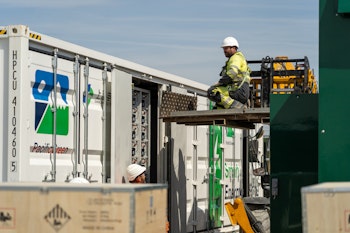With so many factors to consider, it is not surprising that DNV’s 2023 Energy Transition Outlook report has as many downs as it does ups.
Laying out its findings, Remi Eriksen, DNV group president and CEO, said that if the term ‘energy transition’ implies a complete replacement of fossil fuels with clean energy then the industry is most definitely not where it needs to be, and in many ways hasn’t even made a dent.
DNV acknowledges that overall costs for solar and wind power are dropping, but global trends show that record emissions from fossil energy are projected to rise even further in the coming year.
Complicating matters, 2023 has become a year that encapsulates not just the Russian-Ukraine war but also the critical situation in Gaza and Israel.
The Middle East plays a crucial role in global energy markets as a major exporter of fossil fuels, holding 48% of proved oil reserves and accounting for 31% of global oil and 18% of gas production.

Threats to fossil fuel supplies mean steps now taken to address the energy trilemma–the issues of security, affordability and sustainability–will ultimately decide whether emissions can be reduced to net zero by 2050.
Heightening the challenge are a gridlock in decarbonization technology, administrative red tape and geopolitical unrest.
But last year also saw an increase in the levelized cost of renewables in several regions, particularly related to wind projects, and DNV forecasts that cost reductions will “return to historic learning curve rates by 2028.”
Eriksen says short-term energy forecasting is a thankless task “in the recent context of the pandemic, war and price shock,” but is keen to stress that the long view is more positive.
DNV’s report states that electrification will more than double between now and 2050, and that “globally, we have the means to keep the world on track to be at, or very near, net zero by mid-century.”
The report highlights a handful of key developments within the industry that have either helped or hindered the road to net zero so far. These are:
- Energy security is becoming a priority. Factors such as price shocks for energy importers, complex supply chains, inflation and disruptions in energy supplies have heightened the focus on energy security. Governments are increasingly preferring locally produced energy over imports, with DNV estimating a willingness to pay a premium of 6% to 15% for domestically sourced energy.
- Policies such as the US Inflation Reduction Act and the European Union’s Green Deal, REPowerEU and Fit for 55 packages are speeding up transition. As countries compete in terms of clean energy, advancements in technologies such as hydrogen and carbon capture and storage will yield global benefits.
- Global emissions are decreasing, but not quickly enough. DNV forecasts that global energy-related carbon emissions in 2050 will be 46% lower than today but with only a 4% reduction by 2030. Limiting global warming to 1.5 degrees above pre-industrial levels seems increasingly challenging.
- Renewables are surpassing fossil fuels, it but could take 27 years just to shift the energy mix to 48% fossil and 52% non-fossil fuel. Wind and solar are expected to grow tenfold and 17-fold, respectively, between now and 2050. From 2025 onwards, nearly all new capacity will be low-carbon.
- The energy transition is “still at the starting blocks.” Global energy-related emissions continue to rise, with an expected peak coming in the next year, but an increase in new oil and gas projects and disruptions in the oil market are causing delays in the transition process.
- Gridlock is hindering the short-term expansion of decarbonisation technologies. Transmission and distribution grid limitations are emerging as bottlenecks for the expansion of renewable energies and electric vehicle charging points.

With all this to consider, the report places battery storage under the spotlight. Flexibility is key to managing the transition to net zero and lithium-ion (Li-ion) batteries are key to more flexible grids. The report predicts Li-ion battery storage capacity will reach 1.6 TWh by 2030.
Despite supply chain challenges, DNV says lithium-ion is on the “brink of innovation” and expects the cost of utility-scale Li-ion battery energy storage system technology to fall below $200 per kWh by 2030, and even as low as around $130 per kWh by 2050.
We would argue that this projection is conservative given the significant amounts being invested in vehicle electrification. With much activity in China, South Korea, Japan and the US, DNV projects that by 2050 the total capacity of Li-ion installations will reach 22 TWh.
Most of this capacity will be in the form of lithium-ion batteries paired with utility-scale solar photovoltaic (PV) systems, with a smaller portion dedicated to stand alone Li-ion battery storage.
Additionally, there will be a gradually expanding segment of long-duration energy storage (LDES) technologies that will contribute to around 1.4 TWh by 2050.
DNV notes that any energy source will require longer durations of storage to avoid costly curtailment, and sees LDES technology, and particularly vanadium redox flow batteries, as “promising for eight to 23-hour applications,” with potential cost advantages over Li-ion.
Hydrogen will also play a part in the energy storage market, but its development is lagging. To meet Paris Agreement targets it needs to make up around 15% of the world’s energy demand by 2050.
Current projections indicate that hydrogen could meet only 0.5% of the global energy mix in 2030, rising to 5% in 2050.
Despite this modest contribution, significant advancements in hydrogen technology and infrastructure are expected, with estimated global expenditures of $6.8 trillion for hydrogen production, $180 billion for pipelines and $430 billion for ammonia terminals.
The demand for hydrogen as an energy carrier will grow substantially, with manufacturing (58%), transport (20%) and buildings (14%) being the primary applications.
The report concludes, unsurprisingly, that achieving a net zero energy system by 2050, to secure a 1.5°C warming future, seems more difficult than ever.
DNV sees the world’s energy system moving from an energy mix that is 80% fossil-based to one that is about 50% non-fossil-based in the space of a single generation. The question is, will this be fast enough?
Publish date: 12 November, 2023